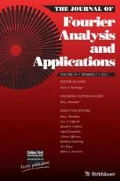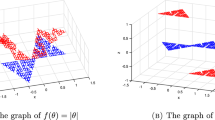Abstract
Although the “hot spots” conjecture was proved to be false on some classical domains, the problem still generates a lot of interests on identifying the domains that the conjecture hold. The question can also be asked on fractal sets that admit Laplacians. It is known that the conjecture holds on the Sierpinski gasket and its variants. In this note, we show surprisingly that the “hot spots” conjecture fails on the hexagasket, a typical nested fractal set. The technique we use is the spectral decimation method of eigenvalues of Laplacian on fractals.







Similar content being viewed by others
References
Atar, R., Burdzy, K.: On Neumann eigenfunctions in lip domains. J. Am. Math. Soc. 17, 243–265 (2004)
Bajorin, N., Chen, T., Dagan, A., Emmons, C., Hussein, M., Khalil, M., Mody, P., Steinhurst, B., Teplyaev, A.: Vibration nodes of \(3n\)-gaskets and other fractals. J. Phys. A 41, 015101 (2008)
Bañuelos, R., Burdzy, K.: On the “hot spots” conjecture of J. Rauch. J. Funct. Anal. 164, 1–33 (1999)
Burdzy, K.: The hot spots problem in planar domains with one hole. Duke Math. J. 129, 481–502 (2005)
Burdzy, K.: Brownian Motion and its Applications to Mathematical Analysis, Lecture Notes in Math, vol. 2106. Springer, New York (2014)
Burdzy, K., Werner, W.: A counterexample to the “hot spots” conjecture. Ann. Math. 149, 309–317 (1999)
Drenning, S., Strichartz, R.S.: Spectral decimation on hambly’s homogeneous hierarchical gaskets. Ill. J. Math. 53, 915–937 (2009)
Fukushima, M., Shima, T.: On a spectral analysis for the Sierpinski gasket. Potential Anal. 1, 1–35 (1992)
Ionescu, M., Pearse, E.P.J., Rogers, L.G., Ruan, H.-J., Strichartz, R.S.: The resolvent kernel for p.c.f. self-similar fractals. Trans. Am. Math. Soc. 362, 4451–4479 (2010)
Jerison, D., Nadirashvili, N.: The “hot spots” conjecture for domains with two axes of symmetry. J. Am. Math. Soc. 13, 741–772 (2000)
Kawohl, B.: Rearrangements and Convexity of Level Sets in PDE, Lecture Notes in Math, vol. 1150. Springer, Berlin (1985)
Kigami, J.: A harmonic calculus on the Sierpinski spaces. Jpn. J. Appl. Math. 6, 259–290 (1989)
Kigami, J.: Harmonic calculus on p.c.f. self-similar sets. Trans. Am. Math. Soc. 335, 721–755 (1993)
Kigami, J.: Analysis on Fractals. Cambridge University Press, Cambridge (2001)
Li, X.-H., Ruan, H.-J.: The “hot spots” conjecture on higher dimensional Sierpinski gaskets. Commun. Pure. Appl. Anal. 15, 287–297 (2016)
Lindstrøm, T.: Brownian motion on nested fractals. Mem. Am. Math. Soc. 420, 1–128 (1990)
Rammal, R.: Spectrum of harmonic excitations on fractals. J. Phys. 45, 191–206 (1984)
Rammal, R., Toulouse, G.: Random walks on fractal structrues and percolation clustars. J. Phys. Lett. 44, L13–L22 (1982)
Ruan, H.-J.: The “hot spots” conjecture for the Sierpinski gasket. Nonlinear Anal. 75, 469–476 (2012)
Ruan, H.-J., Zheng, Y.-W.: The “hot spots” conjecture on the level-3 Sierpinski gasket. Nonlinear Anal. 81, 101–109 (2013)
Shima, T.: On eigenvalue problems for the random walks on the Sierpinski pre-gaskets. Jpn. J. Ind. Appl. Math. 8, 127–141 (1991)
Shima, T.: On eigenvalue problems for Laplacians on p.c.f. self-similar sets. Jpn. J. Ind. Appl. Math. 13, 1–23 (1996)
Strichartz, R.S.: Differential Equations on Fractals. Princeton University Press, Princeton (2006)
Acknowledgements
The authors wish to thank Professors Qi-Rong Deng and Robert Strichartz for their valuable discussions and suggestions. We are also grateful to the referees for their helpful comments. The research of Lau is supported in part by the HKRGC Grant and the NSFC Grant 11371382. The research of Ruan is supported in part by the NSFC Grant 11271327, and by ZJNSFC Grant LR14A010001.
Author information
Authors and Affiliations
Corresponding author
Additional information
Communicated by Robert S. Strichartz.
Appendix: Laplacian and Normal Derivative on Hexagasket
Appendix: Laplacian and Normal Derivative on Hexagasket
In this appendix, we derive the definition of Laplacian and normal derivative of the hexagasket, in Definitions 2.1, 2.2, following the general method in [14].
For any finite set U and V, we let \(\ell (U)=\{f:\; f \text{ maps } U \text{ into } \mathbb {R} \}\), denote
and \(L(U)=L(U,U)\). It is clear that for each \(A\in L(U,V)\), there exists a unique matrix, denoted by \(\{A_{pq}\}_{p\in V,q\in U}\), such that for any \(f\in \ell (U)\),
We will use the same notation for both linear map and the corresponding matrix. We define \(\mathcal {H}(V)\) to be the collection of symmetric and irreducible matrix D in L(V) satisfying following two conditions: (i) \(D_{pp}<0\) and \(\sum _{q\in V} D_{pq}=0\) for all \(p\in V\); (ii) \(D_{pq}\ge 0\) if \(p\not =q\).
Let K be a connected p.c.f. self-similar set with contractive maps \(\{F_i\}_{i=1}^{N}\) on \({\mathbb {R}}^d\), and let \(V_0\) be the boundary of K. Given \(D\in \mathcal {H}(V_0)\) and \(\mathbf {r}=(r_1, r_2, \ldots , r_N)\), where \( r_i>0\) for all i, we define \(H_m\) for any \(m>0\) by
where \(R_\omega \in L(V_m,V_0)\) is defined by \(R_\omega f=f\circ F_\omega \), and \(r_\omega =r_{\omega _1},\ldots , r_{\omega _m}\) for \(\omega =(\omega _1,\ldots ,\omega _m) \in \Sigma ^m.\) Decompose \(H_1\) into
where \(T\in L(V_0), J\in L(V_0, V_1{\setminus } V_0)\) and \(X \in L(V_1{\setminus } V_0)\). As Sect. 3.1 in [14], we call \((D,\mathbf {r})\) a harmonic structure if
Given a continuous function u on K. We call u harmonic if \((H_mu)|_{V_m{\setminus } V_0}=0\) for all \(m\ge 1\), and call u a piecewise harmonic spline of level m if \(u\circ F_\omega \) is harmonic for all \(\omega \in \Sigma ^m.\)
Let \(\mu \) be the standard self-similar measure on K [i.e., \(\mu (K)=1\) and \(\mu (\cdot )=\sum _{i=1}^N \frac{1}{N}\mu (F_i^{-1}(\cdot ))\)], the following definitions of Laplacian and normal derivative are given in Sect. 6 in [13].
Definition 4.5
Assume that \((D,\mathbf {r})\) is a harmonic structure on K. For u a continuous function on K, we write \(\Delta u=f\) if there exists a continuous function f on K such that
where \(\psi _x^{(m)}\) is the piecewise harmonic spline of level m satisfying \(\psi _x^{(m)}(y)=\delta _{xy}\) for all \(y\in V_m\).
Definition 4.6
Assume that \((D,\mathbf {r})\) is a harmonic structure on K. Given a continuous function u on K. For \(q\in V_0 \), we define the Neumann derivative of u at q to be (if the limit exists)
Now for the hexagasket, let
where \(r>0\). It is easy to check that \((D,\mathbf {r})\) is a harmonic structure if and only if \(r=\frac{3}{7}\). Thus, throughout the paper, we always choose \(r=\frac{3}{7}\) so that
Let \(\mu \) be the standard self-similar measure on the hexagasket. Similar to Sect. 2.2 in [23], we obtain that \(\int _{K} \psi _x^{(m)} \, \mathrm{d}\mu = {\deg _m(x)}/{6^{m+1}}\). As by definition, \(\Delta _mu(x)=\frac{1}{\deg _m(x)}\sum _{y\sim _mx}(u(y)-u(x))\) for \(x\in V_m{\setminus } V_0\), we have for \( x\in V_*{\setminus } V_0,\)
and for \(q_i \in V_0\),
Rights and permissions
About this article
Cite this article
Lau, KS., Li, XH. & Ruan, HJ. A Counterexample to the “Hot Spots” Conjecture on Nested Fractals. J Fourier Anal Appl 24, 210–225 (2018). https://doi.org/10.1007/s00041-017-9524-z
Received:
Published:
Issue Date:
DOI: https://doi.org/10.1007/s00041-017-9524-z




